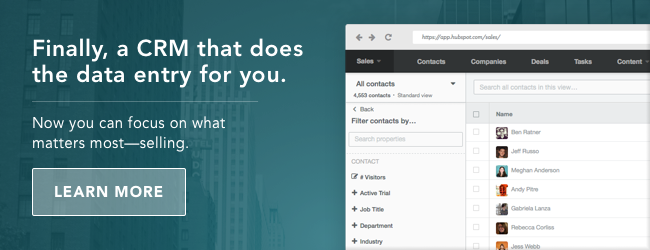

Any marketer can tell you that marketing has become a data-driven discipline. Most of us can tell you what metrics we track for our efforts at the top and middle of the funnel. Traffic? Check. Leads? Check. Opportunities? Check.
But as our efforts fall further down the funnel, measurement gets much harder. When it comes to sales enablement, there’s no one number that can measure the results of your efforts or tell you what projects to prioritize.
So what's a data-driven sales enablement marketer to do? How do you definitively prove you're fostering a healthy relationship between Marketing and Sales? It’s harder to measure than most other types of marketing, but below are a few quantitative and qualitative ways to track your results.
1) Use the lead-to-customer conversion rate as your North Star.
The mission of a sales enablement team is to help the sales team close more deals. In other words, said with a funnel lens, their mission is to increase the lead-to-customer conversion rate.
Your lead-to-customer conversion rate is a good number to track to help measure the impact of your sales enablement activities. Although it is influenced by a number of other variables, such as the absolute number and quality of leads generated, it’s a good indicator. The effectiveness of the sales reps also comes into play, but this is actually something that you should be helping to influence. (More on that later.) Lead-to-customer is especially good to track over time to identify trends.
This metric is also important to keep in mind when deciding which projects to take on yourself and which to leave to other marketers. The next time your CMO or VP of Sales asks you to create a campaign, ask yourself, “Will this help us close more customers?” If you only take on projects where the answer is “yes,” you will stay focused on bottom-of-the-funnel activities and have a clear reason why you leave demand gen efforts up to your colleagues.
Tip: You can calculate your lead-to-customer conversion rate as long as you know the number of leads and customers generated in a particular time period. If you have a CRM, it may include reporting tools that do it for you.
2) Measure win/loss rates against key competitors.
Your sales team needs your help the most on the toughest deals. Looking at your win/loss rate will help you measure how well you are equipping your sales team when they’re up against the competition. You should drill in to this data by customer segment and sales team. Not only will this give you a performance metric, but it will also help you figure out where you should invest more energy.
Tip: You can calculate your win/loss rate wherever you track deal stages, most often in your CRM system.
3) Post your content online.
Content doesn't just have to support your top-of-the-funnel goals -- you should be publicizing your sales content such as customer stories, product overviews, ROI studies, and anything on video. This will help you get better data about who is viewing your content and how much it’s influencing their decision to buy (or not).
Post your content online so you can better measure click-through rates from your emails and generate organic traffic. You'll still need to arm your reps with some more printer-friendly documents and PowerPoint decks to present, but always be thinking about how you can scale online, too.
Tip: Make sure you are using an analytics tool with your content management system, or have an all-in-one solution like the HubSpot Marketing Platform.
4) Perform attribution reporting.
Another great thing about posting content online is that you can then run attribution reports to see how much influence each piece had in helping turn existing leads into customers. Of course they likely touched many pieces of content, but this analysis tells you what content they discover and are interested in late in the buyer’s journey. For example, you could use an attribution report to figure out which of your customer stories are resonating most with your audience.
Tip: HubSpot’s Marketing Platform helps marketers make customized attribution reports through its Reports App.
5) Pick the right software for sharing content with sales.
Like I mentioned before, you won’t be able to post all of your content online -- some of it may need to be in a more printer-friendly or presentation-ready format. But before you post it up on Google Drive, think about how often you’ll be making updates to those documents. You don’t want your sales reps frustrated by outdated links to their favorite collateral. And you want to get as much insight as you can about who is downloading what content, who they’re sending it to, and who is opening it.
There are a number of sales software options on the market that can integrate with your CRM and/or marketing software platforms to help you track the delivery of content in any file format.
Tip: If your CRM and/or marketing software doesn't have this capability, the next best option is to use cloud storage tools like Box.com that can at least tell you the number of downloads. You won’t know if or how your leads are interacting with the content, but you will know what pieces your sales reps are using most.
6) Sit with your sales team.
I’m not talking about sitting down with sales leadership once a month. Sit with your sales team every single day -- your team’s desks should be next to theirs. You may organizationally sit with Marketing or Sales, but either way, you should physically sit with Sales.
Sitting with Sales helps you see what content they are sharing on their screens, hear what they are saying to prospects, and it makes you more accessible to answer questions and receive feedback. Why spend a lot of time trying to coordinate sales calls and demos to listen in on when it can happen so naturally? It’s totally okay to eavesdrop on salespeople. In fact, it’s your job.
Tip: Make sure you invest in some nice noise-cancelling headphones for days when you need to get in the zone and create a lot of content.
7) Count your content production.
At HubSpot, our sales team loves to share case studies with prospects since our customers tell their story better than we can. Because of that, our sales enablement team can get overwhelmed with requests to write case studies for customers who are in a specific geography, industry, or faced a certain marketing challenge. We can’t keep up with all of the requests, so it helps when we can explain how many case studies we’ve written in a quarter and how we prioritize them. We’ll eventually get to that obscure industry customer in the Maldives whose social media efforts weren’t generating leads for them.
Tip: Keep a simple spreadsheet or document to track and date stamp the content your team is producing -- and make sure the sales team can easily access it.
8) Watch and measure product demos.
By sitting with your sales team, you’ll have some qualitative data about how they are demoing your product or service. Also ask reps to record demos so you get a broad understanding of how they're selling your product. And you also may have an opportunity to gather quantitative data about those demos depending on what business you're in.
Tip: If you’re a SaaS company, you can pull usage data to see what pieces of the product the sales reps are showing on demoing. They might not have the right sales training or content to demo the apps they’re not showing. If your company has a physical product, you can track what inventory they request to demo or share as trials.
9) Survey the sales team to generate your NPS.
NPS, or Net Promoter Score, helps you objectively measure the satisfaction of your stakeholders. Once you know how to calculate the NPS formula, you can set up a simple survey to ask the sales team how likely they’d be to recommend your work.
Use the survey as a way to get additional feedback such as what training topics they’d like covered in sales training, what content they think is most effective, and what else they’d like to see from your team. But keep the survey short and easy to fill out -- remember that every minute a sales person is filling out your survey is a minute they’re not on the phone with potential customers.
Tip: Simply using a Google form or setting up a basic Survey Monkey are easy ways to set up a survey if your company doesn’t have a license for other software.
What other ways do you measure sales enablement?
